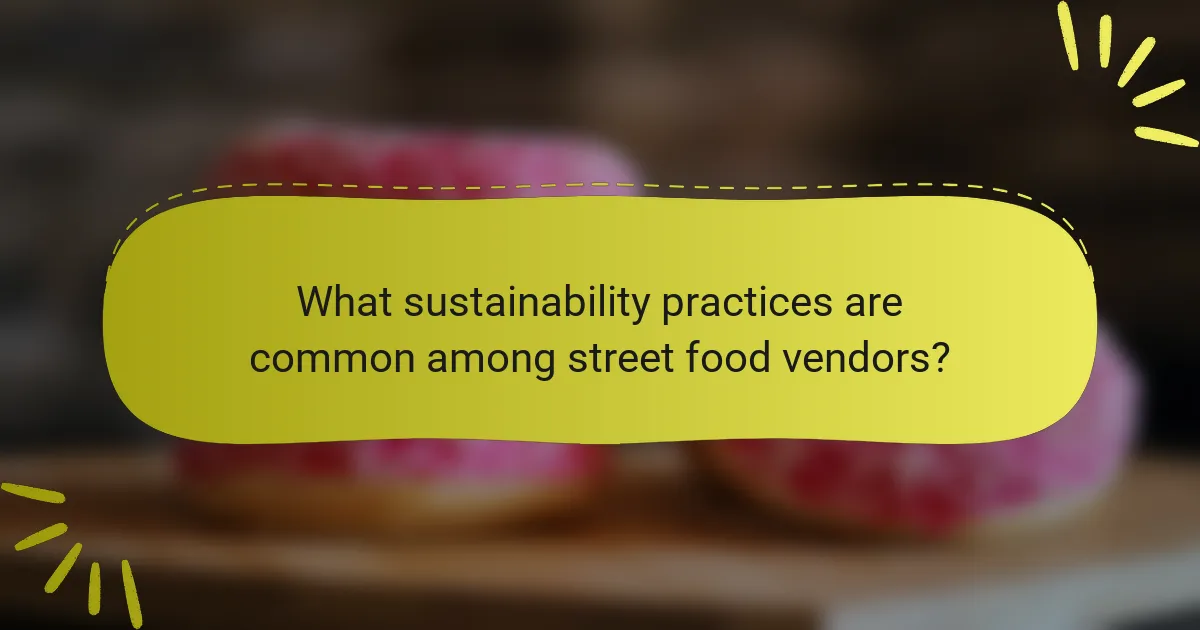Eco-friendly street food options focus on sustainability through the use of plant-based dishes, locally sourced ingredients, and biodegradable packaging. These practices aim to minimize environmental impact while providing nutritious meals. Key sustainability practices among street food vendors include utilizing compostable materials, implementing waste management strategies, and engaging in community education about environmentally conscious eating. The menu choices often feature seasonal produce, organic ingredients, and diverse ethnic cuisines that prioritize sustainability. Collectively, these efforts contribute to a more sustainable food system, making eco-friendly street food both a delicious and responsible choice.

What are eco-friendly street food options?
Eco-friendly street food options include plant-based dishes, locally sourced ingredients, and biodegradable packaging. These options minimize environmental impact while providing nutritious meals. For instance, vegan tacos made with organic vegetables reduce meat consumption. Food trucks using compostable utensils contribute to waste reduction. Markets that prioritize seasonal produce support local farmers. Additionally, street vendors that serve dishes in reusable containers promote sustainability. Research shows that plant-based diets can lower carbon footprints significantly. These practices collectively make street food more eco-friendly.
How do eco-friendly street food options contribute to sustainability?
Eco-friendly street food options contribute to sustainability by minimizing waste and using local ingredients. These food vendors often utilize biodegradable packaging, which reduces plastic pollution. They frequently source their ingredients from nearby farms, supporting local economies and reducing transportation emissions. Many eco-friendly street food options also prioritize plant-based dishes, which have a lower carbon footprint compared to meat-based meals. Research indicates that plant-based diets can reduce greenhouse gas emissions by up to 50%. Additionally, these vendors often implement practices like composting food scraps, further reducing waste. Overall, eco-friendly street food options play a significant role in promoting sustainable food practices.
What are the key characteristics of sustainable street food?
Sustainable street food is characterized by environmentally friendly practices, local sourcing, and ethical production methods. It minimizes waste through compostable packaging and encourages the use of seasonal ingredients. Sustainable street food vendors often engage in fair trade practices, ensuring fair wages for producers. They also prioritize animal welfare by sourcing meat from humane farms. Nutritional value is emphasized, with a focus on healthy, plant-based options. Studies show that sustainable food practices can reduce carbon footprints significantly. For example, local sourcing can cut transportation emissions by up to 60%.
How do eco-friendly practices impact food quality and safety?
Eco-friendly practices enhance food quality and safety by promoting sustainable farming and reducing harmful chemicals. Sustainable farming methods, such as organic farming, improve soil health and biodiversity. Healthier soil leads to better nutrient retention in crops. This results in higher-quality produce with more vitamins and minerals.
Additionally, eco-friendly practices reduce the use of pesticides and synthetic fertilizers. This minimizes chemical residues on food, making it safer for consumption. Research indicates that organic produce has lower pesticide levels compared to conventionally grown food.
Moreover, eco-friendly practices often include proper food handling and storage techniques. These practices reduce the risk of foodborne illnesses. For example, using compostable materials can prevent contamination.
Overall, the integration of eco-friendly practices significantly contributes to the quality and safety of food offered in street food options.
Where can you find eco-friendly street food options?
Eco-friendly street food options can be found in urban areas known for sustainability initiatives. Cities like San Francisco, Portland, and Amsterdam have vibrant eco-friendly street food scenes. Food trucks and stalls in these locations often prioritize local, organic ingredients. Many vendors use biodegradable or compostable packaging. Additionally, farmers’ markets frequently feature eco-conscious food vendors. Events focused on sustainability also showcase eco-friendly street food. Research indicates that urban areas with green certifications tend to support such food options. This trend reflects a growing consumer demand for sustainable dining choices.
What locations are known for their eco-friendly street food vendors?
Cities known for eco-friendly street food vendors include Portland, Oregon; Bangkok, Thailand; and Berlin, Germany. Portland has a strong focus on sustainability, with many vendors using local, organic ingredients. Bangkok features street vendors who prioritize biodegradable packaging and fresh produce. Berlin is recognized for its diverse offerings, including vegan and vegetarian options that emphasize eco-conscious practices. These cities exemplify the growing trend of environmentally friendly street food.
How does location influence the availability of sustainable options?
Location significantly influences the availability of sustainable options. Urban areas often have better access to local farms and suppliers. This proximity allows street food vendors to source fresh, organic ingredients. In contrast, rural areas may rely on less sustainable, mass-produced food due to limited access. Geographic factors also affect transportation costs and logistics. Regions with established eco-friendly practices may promote sustainable options more effectively. For example, cities like San Francisco have policies supporting local, sustainable food systems. These policies create a favorable environment for eco-friendly street food vendors.

What sustainability practices are common among street food vendors?
Common sustainability practices among street food vendors include using biodegradable packaging. Many vendors opt for eco-friendly materials to reduce plastic waste. They often source ingredients locally to minimize transportation emissions. This practice supports local economies and ensures fresher produce.
Street food vendors frequently implement waste management strategies. They separate organic waste for composting and recycle whenever possible. Some vendors also adopt energy-efficient cooking methods, reducing their carbon footprint.
Additionally, many street food vendors engage in community education on sustainability. They promote environmentally conscious eating habits among their customers. These practices collectively contribute to a more sustainable food system.
How do street food vendors source their ingredients sustainably?
Street food vendors source their ingredients sustainably by prioritizing local produce. They often establish relationships with nearby farmers to reduce transportation emissions. Many vendors choose organic ingredients to minimize chemical use. Seasonal sourcing is common, as it aligns with local harvests. This practice supports biodiversity and local economies. Some vendors also utilize food waste by incorporating leftover ingredients into their dishes. Additionally, they may participate in community-supported agriculture (CSA) programs. These methods collectively enhance the sustainability of their food offerings.
What are the benefits of local sourcing for street food?
Local sourcing for street food offers several benefits. It supports local economies by keeping money within the community. This practice reduces transportation emissions, contributing to lower carbon footprints. Freshness is enhanced, as ingredients are harvested at peak ripeness. Local sourcing often leads to better flavor and quality of food. It fosters relationships between vendors and local farmers, promoting sustainable agricultural practices. Additionally, it can create unique menu items that reflect local culture and traditions. Research indicates that consumers increasingly prefer food that is locally sourced, driving demand for street vendors to adopt this practice.
How does seasonal availability affect menu choices?
Seasonal availability significantly influences menu choices by determining what ingredients are fresh and locally sourced. Restaurants often design menus around seasonal produce to ensure quality and flavor. This practice supports local farmers and reduces transportation emissions. For example, a summer menu may feature tomatoes and cucumbers, while a winter menu might include root vegetables and hearty greens. Seasonal menus can enhance customer experience by offering dishes that align with the time of year. Additionally, this approach can result in cost savings due to lower prices for in-season ingredients. Overall, seasonal availability shapes menu offerings, promotes sustainability, and enhances food quality.
What waste management practices do eco-friendly vendors implement?
Eco-friendly vendors implement several waste management practices to minimize their environmental impact. They often utilize compostable packaging to reduce plastic waste. Many vendors also practice waste segregation, separating recyclables from organic waste. This promotes proper recycling and composting efforts. Additionally, some vendors participate in local composting programs to divert food waste from landfills. They may also encourage customers to bring reusable containers to limit single-use items. Many eco-friendly vendors track their waste generation to improve their practices over time. These strategies contribute to a more sustainable food service model.
How do these practices minimize environmental impact?
Eco-friendly street food practices minimize environmental impact by reducing waste and resource consumption. These practices include using biodegradable packaging and utensils. This approach decreases plastic waste significantly. Sourcing ingredients locally also lowers carbon emissions from transportation. Sustainable menu choices often feature plant-based options, which require fewer resources than meat. Implementing energy-efficient cooking methods further conserves energy. Collectively, these strategies contribute to a smaller ecological footprint. Studies show that sustainable food practices can reduce greenhouse gas emissions by up to 30%.
What are the challenges faced in waste management for street food?
Challenges in waste management for street food include inadequate disposal facilities. Many street vendors lack access to proper waste bins. This leads to littering and environmental pollution. Additionally, there is often a lack of awareness about waste segregation. Vendors may not know how to separate organic waste from recyclables. Health regulations can also be challenging for street food vendors. Compliance with these regulations often requires additional resources. Furthermore, fluctuating customer volumes can result in inconsistent waste generation. This makes it difficult to manage waste effectively. According to a study by the Food and Agriculture Organization, food waste in urban settings can reach 30-40%. This highlights the urgency of addressing these waste management challenges.

What menu choices are available in eco-friendly street food?
Eco-friendly street food offers a variety of menu choices that prioritize sustainability. Common options include plant-based dishes such as vegan tacos and lentil burgers. Many vendors serve organic produce sourced from local farms. Street food may also feature biodegradable packaging to reduce waste. Dishes often incorporate seasonal ingredients to minimize environmental impact. Additionally, some vendors provide gluten-free and allergen-friendly options. Ethnic cuisines, like Thai and Indian, frequently include eco-conscious dishes made with sustainable ingredients. Overall, eco-friendly street food combines taste and sustainability in diverse offerings.
How do eco-friendly street food options cater to various dietary preferences?
Eco-friendly street food options cater to various dietary preferences by offering diverse menu choices. These options often include vegetarian, vegan, gluten-free, and organic items. Many vendors source local and seasonal ingredients to enhance freshness and sustainability. This approach accommodates health-conscious consumers and those with dietary restrictions. For instance, a study by the Food and Agriculture Organization (FAO) highlights the increasing demand for plant-based foods. Additionally, eco-friendly practices attract environmentally aware customers. Street food vendors often use biodegradable packaging, appealing to eco-conscious individuals. This combination of dietary inclusivity and sustainable practices enhances the overall appeal of eco-friendly street food.
What types of vegan and vegetarian options are commonly found?
Common vegan and vegetarian options include plant-based dishes, salads, and grain bowls. Vegan options often feature legumes, tofu, and vegetables. Vegetarian choices may include dairy products like cheese and eggs. Street food vendors frequently offer falafel, veggie burgers, and wraps. Additionally, many serve smoothies and fruit bowls. These options cater to health-conscious consumers. The rise in plant-based eating reflects growing environmental awareness. Studies show that plant-based diets reduce carbon footprints.
How do gluten-free options fit into eco-friendly street food menus?
Gluten-free options fit into eco-friendly street food menus by providing inclusive dietary choices while minimizing environmental impact. These options often utilize locally sourced ingredients, reducing transportation emissions. Many gluten-free ingredients, such as quinoa and rice, require less water and land compared to traditional wheat. This aligns with sustainable practices that prioritize resource conservation. Additionally, gluten-free street food can cater to diverse dietary needs, promoting health and wellness. By offering these options, vendors can attract a wider customer base, enhancing business sustainability.
What innovative dishes are emerging in the eco-friendly street food scene?
Innovative dishes emerging in the eco-friendly street food scene include plant-based tacos, vegan sushi rolls, and jackfruit burgers. These dishes often utilize locally sourced ingredients to minimize carbon footprints. For example, plant-based tacos feature ingredients like lentils and seasonal vegetables. Vegan sushi rolls may incorporate ingredients such as avocado and cucumber, reducing reliance on fish. Jackfruit burgers use the fruit as a meat alternative, providing a sustainable protein source. Many vendors adopt biodegradable packaging to enhance their eco-friendly practices. The rise of these dishes reflects a growing consumer demand for sustainable food options.
How do cultural influences shape these innovative menu choices?
Cultural influences shape innovative menu choices by integrating traditional flavors and ingredients from various cuisines. Street food vendors often draw inspiration from local customs and culinary practices. This results in unique dishes that reflect the community’s heritage. For example, fusion cuisines combine elements from different cultures, creating novel offerings. Additionally, cultural values around sustainability can drive menu innovations. Vendors may prioritize local, organic ingredients due to community preferences. Research indicates that street food reflects regional identity, enhancing its appeal. Overall, cultural influences play a crucial role in the evolution of eco-friendly menu options.
What role does creativity play in attracting customers to eco-friendly options?
Creativity plays a crucial role in attracting customers to eco-friendly options. It differentiates these options in a crowded market. Innovative branding and unique presentations capture consumer attention. Engaging storytelling about sustainability resonates with eco-conscious customers. For example, vibrant packaging made from recycled materials enhances visual appeal. Creative menu items can highlight local and organic ingredients. This approach fosters a connection between consumers and the values of sustainability. Research indicates that 73% of millennials are willing to pay more for sustainable products, showcasing the effectiveness of creative marketing in this sector.
What tips can consumers follow to identify eco-friendly street food options?
Consumers can identify eco-friendly street food options by observing several key factors. First, look for vendors using biodegradable or compostable packaging. This indicates a commitment to reducing plastic waste. Second, assess the ingredients used in the food. Locally sourced ingredients often signify a lower carbon footprint. Third, consider the vendor’s cooking methods. Options that utilize energy-efficient appliances or techniques are more sustainable. Fourth, inquire about the vendor’s waste management practices. Vendors who compost or recycle demonstrate eco-consciousness. Lastly, check for certifications or labels indicating organic or sustainable practices. These factors collectively help consumers make informed choices about eco-friendly street food options.
Eco-friendly street food options encompass sustainable practices, locally sourced ingredients, and diverse menu choices that prioritize environmental responsibility. This article explores how these options contribute to sustainability by minimizing waste, supporting local economies, and enhancing food quality through organic farming methods. Key characteristics of sustainable street food, including waste management strategies and the influence of location on availability, are discussed alongside innovative dishes reflecting cultural influences. Additionally, tips for consumers to identify eco-friendly street food vendors are provided, highlighting the growing demand for sustainable dining experiences.